- Tips for caring and maintenance of Chrysanthemum in a pot
- Choosing the right pot
- Size
- Drainage
- Material
- Appearance
- Number of plants
- Maintenance
- Soil selection and preparation
- Types of soil
- Preparing the soil
- Watering techniques
- Sunlight Requirements
- Fertilizing the plant
- 1. Choose the right fertilizer
- 2. Follow the recommended application rate
- 3. Timing of fertilizer application
- 4. Apply fertilizer evenly
- 5. Water after fertilizing
- 6. Use organic fertilizers
- Pruning and pinching
- Pruning
- Pinching
- Dealing with pests and diseases
- Pests
- Diseases
- Propagation methods
- 1. Division
- 2. Stem cuttings
- 3. Layering
- Q&A:
- What is the best time to plant chrysanthemums in a pot?
- How often should I water my potted chrysanthemum plant?
- Can I keep my potted chrysanthemum indoors?
- Do potted chrysanthemums require any fertilization?
- How do I prune my potted chrysanthemum plant?
- Video: Best Flowering Plants for Indoors and Outdoors & their complete care
Chrysanthemums, or mums for short, are beautiful flowering plants that are known for their vibrant colors and long blooming period. They are a popular choice for indoor and outdoor gardens, and can be grown in pots for added convenience and versatility. If you want to have a chrysanthemum in a pot, it’s important to know the proper care and maintenance techniques to keep the plant healthy and looking its best.
When choosing a pot for your chrysanthemum, it’s important to select one that has good drainage. Chrysanthemums don’t like to have their roots sitting in water, so make sure the pot has drainage holes at the bottom to allow excess water to escape. You can also use a saucer under the pot to catch any water that drains out, but make sure to empty it regularly to prevent water from accumulating and causing root rot.
Chrysanthemums prefer well-draining soil that is rich in organic matter. You can use a mix of garden soil and compost to create a suitable growing medium. Make sure to fertilize the plant regularly to provide it with the necessary nutrients for healthy growth. You can use a balanced fertilizer with equal amounts of nitrogen, phosphorus, and potassium, or a fertilizer specifically formulated for flowering plants.
When it comes to watering, chrysanthemums prefer to be kept evenly moist. You should water the plant thoroughly whenever the top inch of soil feels dry to the touch. Avoid over-watering, as this can lead to root rot. On the other hand, don’t let the plant dry out completely between waterings, as this can stress the plant and cause it to drop its buds or flowers.
In terms of sunlight, chrysanthemums thrive in full sun or partial shade. They need at least 6 hours of direct sunlight each day to produce abundant flowers. If you’re growing chrysanthemums indoors, place the pot near a west or south-facing window to ensure it receives enough light. If you’re growing them outdoors, choose a spot that gets plenty of sunlight, but also offers some protection from harsh afternoon sun.
Lastly, it’s important to keep an eye out for pests and diseases that can affect your chrysanthemum. Common pests include aphids, spider mites, and whiteflies. To prevent infestations, regularly inspect the plant for any signs of pests and treat them with an appropriate insecticide if necessary. Be sure to follow the instructions on the insecticide label carefully to avoid damaging the plant or exposing yourself to harmful chemicals.
Overall, growing a chrysanthemum in a pot can be a rewarding experience. With the right care and maintenance, you can enjoy the beautiful blooms of this versatile plant for weeks or even months on end. Just remember to provide it with the proper drainage, soil, water, sunlight, and protection from pests, and your chrysanthemum will thrive in its pot.
Tips for caring and maintenance of Chrysanthemum in a pot
Growing Chrysanthemums in pots can be a rewarding experience, as these colorful and vibrant flowers can bring beauty and joy to any space. Here are some tips for caring and maintaining Chrysanthemums in a pot:
- Choose the right pot: Select a pot that is big enough to accommodate the root system of the Chrysanthemum plant. The pot should have drainage holes at the bottom to prevent waterlogging.
- Provide well-draining soil: Chrysanthemums prefer well-draining soil that is rich in organic matter. Use a potting mix specifically designed for flowering plants to ensure proper drainage.
- Watering: Water your Chrysanthemum plant regularly, keeping the soil evenly moist but not soggy. Avoid overwatering, as it can lead to root rot. Water the plant at the base to prevent water splashing on the leaves, which can cause diseases.
- Light requirements: Chrysanthemums need at least 6 hours of direct sunlight per day to thrive. Place the pot in a location that receives adequate sunlight, such as near a south or west-facing window.
- Temperature: Chrysanthemums prefer cool temperatures between 55-75°F (13-24°C). Avoid exposing them to extreme heat or cold, as it can damage the plant.
- Fertilizing: Feed your Chrysanthemum plant with a balanced fertilizer once a month during the growing season. Follow the instructions on the fertilizer packaging for the appropriate dosage.
- Pinching and pruning: Pinch back the tips of the Chrysanthemum plant when it reaches a height of 6 inches (15 cm). This will promote bushier growth and more abundant blooms. Prune any wilted or dead flowers regularly to encourage the production of new blooms.
- Pest and disease control: Keep an eye out for common pests such as aphids, mites, and whiteflies. If you notice any signs of infestation or disease, treat the plant with appropriate insecticides or fungicides to prevent further damage.
- Overwintering: In colder climates, Chrysanthemums can be brought indoors during the winter months. Place the pot in a cool, well-lit location and reduce watering. In spring, resume regular care and move the plant back outdoors.
By following these tips, you can ensure the health and vitality of your Chrysanthemum plant in a pot and enjoy its beautiful blooms for a long time.
Choosing the right pot
When choosing a pot for your chrysanthemum, it is important to consider several factors that will contribute to the overall health and well-being of the plant. Here are some tips to help you choose the right pot:
Size
The size of the pot is crucial for the proper growth of the chrysanthemum. It should be large enough to provide adequate space for the root system to grow, but not too large that it hampers drainage and leads to waterlogging. A pot with a diameter of 8-12 inches is generally suitable for most chrysanthemum varieties.
Drainage
Adequate drainage is vital to prevent water from accumulating in the pot and causing root rot. Choose a pot with drainage holes at the bottom to ensure excess water can escape freely. Additionally, consider using a pot with a saucer to catch any excess water that drains out.
Material
There are various materials you can choose from for your chrysanthemum pot, including clay, plastic, and terracotta. Each has its advantages and disadvantages. Clay pots are porous and allow air and water to circulate more freely but can dry out quickly. Plastic pots are lightweight, retain moisture well, and are more durable. Terracotta pots are heavy but provide good insulation for the roots. Consider these factors and choose a pot material that best suits your needs and the specific requirements of your chrysanthemum.
Appearance
While the functionality of the pot is crucial, it is also important to consider the aesthetic appeal. Choose a pot that complements the overall style and décor of your home or garden. There are various designs, colors, and patterns available, allowing you to select a pot that enhances the beauty of your chrysanthemum and adds to the visual appeal of the space.
Number of plants
Consider the number of chrysanthemum plants you intend to grow in one pot. Some chrysanthemum varieties can be planted closely together, while others require more space. Ensure that the pot is large enough to accommodate the desired number of plants and allow adequate air circulation and root growth.
Maintenance
Lastly, consider the maintenance required for the pot material you choose. Some pots may require more frequent watering or protection from extreme temperatures, while others may require occasional cleaning or repainting. Choose a pot that aligns with your maintenance preferences and capabilities.
By considering these factors and choosing the right pot for your chrysanthemum, you can provide an optimal growing environment for your plant and ensure its health and vitality.
Soil selection and preparation
Choosing the right type of soil is crucial for the health and growth of your potted chrysanthemum. Here are some tips on how to select and prepare the soil for your chrysanthemum:
Types of soil
Chrysanthemums thrive in well-draining soil that is rich in organic matter. The soil should also be slightly acidic with a pH level of around 6.5-7.5. Here are some types of soil that are suitable for chrysanthemums:
- Loamy soil: This type of soil is a good option for chrysanthemums as it allows for proper drainage while retaining enough moisture for the plant.
- Sandy soil: If your pot doesn’t have good drainage, sandy soil can help prevent waterlogging and root rot.
- Clay soil: While clay soil can hold too much water, it can be mixed with sand or other organic matter to improve drainage.
Preparing the soil
Before planting your chrysanthemum, it is important to prepare the soil to create a favorable environment for the roots to grow. Follow these steps to prepare the soil:
- Remove any weeds or debris from the top layer of the soil.
- Loosen the soil using a garden fork or tiller to improve aeration and drainage.
- Mix in organic matter such as compost or well-rotted manure to enrich the soil with nutrients.
- Adjust the pH level if needed by adding amendments like lime for acidic soil or sulfur for alkaline soil.
- Water the soil lightly to moisten it before planting the chrysanthemum.
By selecting the right type of soil and preparing it properly, you can provide the ideal growing conditions for your potted chrysanthemum and ensure its healthy development.
Watering techniques
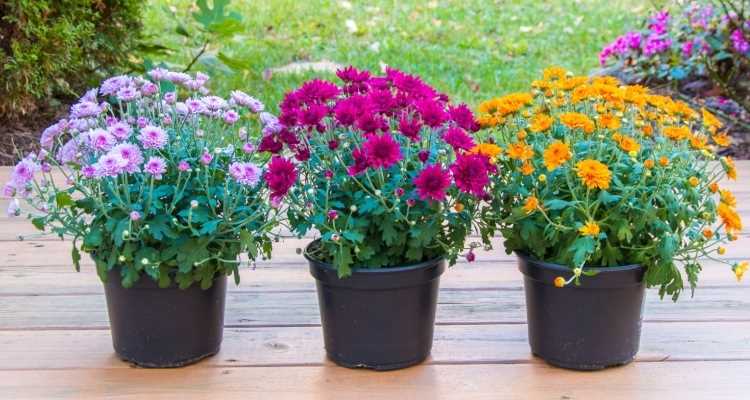
Proper watering is essential for the health and vitality of your chrysanthemum plant in a pot. Here are some watering techniques to ensure you are giving your plant the right amount of water:
- Checking the soil: Before watering, check the moisture level of the soil by sticking your finger about an inch deep into the soil. If it feels dry at this depth, it’s time to water your plant. If the soil feels moist, wait a day or two before watering.
- Watering frequency: Chrysanthemums generally require regular watering, especially during hot summer months. Water your plant every 2-3 days or whenever the soil feels dry.
- Watering technique: When watering, aim to moisten the soil evenly without overwatering. A good technique is to water slowly and deeply, allowing the water to soak into the soil rather than running off the surface. Avoid wetting the foliage as this can lead to fungal diseases.
- Water quality: Chrysanthemums prefer slightly acidic soil, so it’s best to use lukewarm water that has been allowed to stand for at least 24 hours. This helps to neutralize any chlorine or other chemicals present in tap water.
Remember, it’s important to strike a balance when watering your chrysanthemum plant. Overwatering can cause root rot, while underwatering can result in wilting and poor growth. By following these watering techniques, you can help your chrysanthemum thrive and produce beautiful blooms.
Sunlight Requirements
Chrysanthemums are sun-loving plants and thrive in full sunlight. They require a minimum of 6 hours of direct sunlight each day to ensure healthy growth and abundant flowering. Placing your potted chrysanthemum in a location that receives ample sunlight is crucial for its overall well-being.
When selecting a spot for your chrysanthemum, be sure to choose a location that is free from any obstructions that may cast a shadow on the plant. This includes buildings, trees, or other tall plants that may block the sunlight. The more sunlight your chrysanthemum receives, the better it will grow and bloom.
If you are growing your chrysanthemum indoors, place it in a sunny window where it can receive maximum sunlight. South-facing windows are usually the best choice, as they receive the most intense and direct sunlight throughout the day. You may also consider using supplemental grow lights to ensure your chrysanthemum gets enough light if you don’t have access to a sunny window.
In cases where it is not possible to provide the required amount of sunlight, you can still grow chrysanthemums, but they may not thrive as well. Insufficient sunlight can result in weak and leggy growth, sparse foliage, and fewer flowers. If you notice these signs, consider moving your chrysanthemum to a sunnier location or providing supplemental light to ensure its health and vitality.
Fertilizing the plant
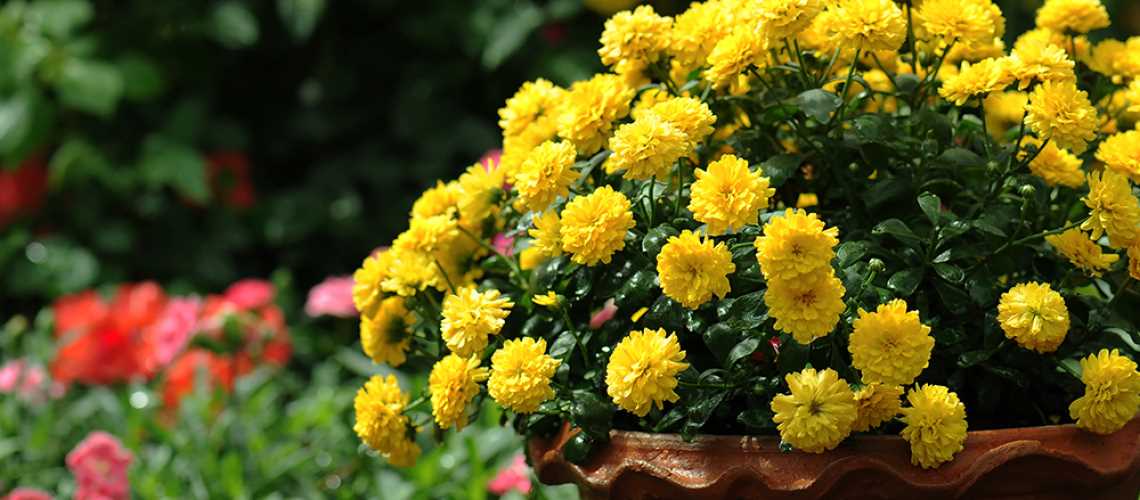
Proper fertilizing is essential for the healthy growth and vibrant blooms of your chrysanthemum in a pot. Fertilizers provide the necessary nutrients that the plant needs to thrive. Here are some tips on fertilizing your chrysanthemum:
1. Choose the right fertilizer
When selecting a fertilizer for your chrysanthemum, choose one that is specifically formulated for flowering plants. Look for a balanced fertilizer that contains equal amounts of nitrogen (N), phosphorus (P), and potassium (K). A ratio of 10-10-10 or 12-12-12 is generally suitable for chrysanthemums.
2. Follow the recommended application rate
Always follow the instructions on the fertilizer package for the recommended application rate. Over-fertilization can lead to burned roots and foliage, while under-fertilization can result in weak growth and poor blooms. Applying too much fertilizer can also increase the risk of diseases and pests.
3. Timing of fertilizer application
Chrysanthemums benefit from regular fertilizing throughout the growing season. Start fertilizing in early spring, as soon as new growth appears. Repeat the fertilizer application every 4-6 weeks until late summer. Avoid fertilizing in late summer or fall, as this can stimulate late growth that may not have time to harden off before winter.
4. Apply fertilizer evenly
When applying fertilizer, distribute it evenly around the base of the plant. Avoid applying fertilizer directly onto the leaves or stems, as this can cause burning. Use a spoon or a small hand-held spreader to ensure an even application.
5. Water after fertilizing
After fertilizing, water the chrysanthemum thoroughly to help the nutrients reach the roots. This will also prevent any potential fertilizer burn on the foliage. Watering also helps to prevent nutrient imbalances in the soil.
6. Use organic fertilizers
If you prefer natural methods of fertilization, you can use organic fertilizers such as compost, well-rotted manure, or fish emulsion. These organic fertilizers provide a slow and steady release of nutrients, promoting healthy growth and blooms.
By following these fertilizing tips, you can ensure that your chrysanthemum in a pot receives the nutrients it needs to thrive and produce beautiful blooms.
Pruning and pinching
Pruning and pinching are important practices when it comes to caring for a chrysanthemum in a pot. These techniques help to promote bushier growth and prevent the plant from becoming too leggy.
Pruning
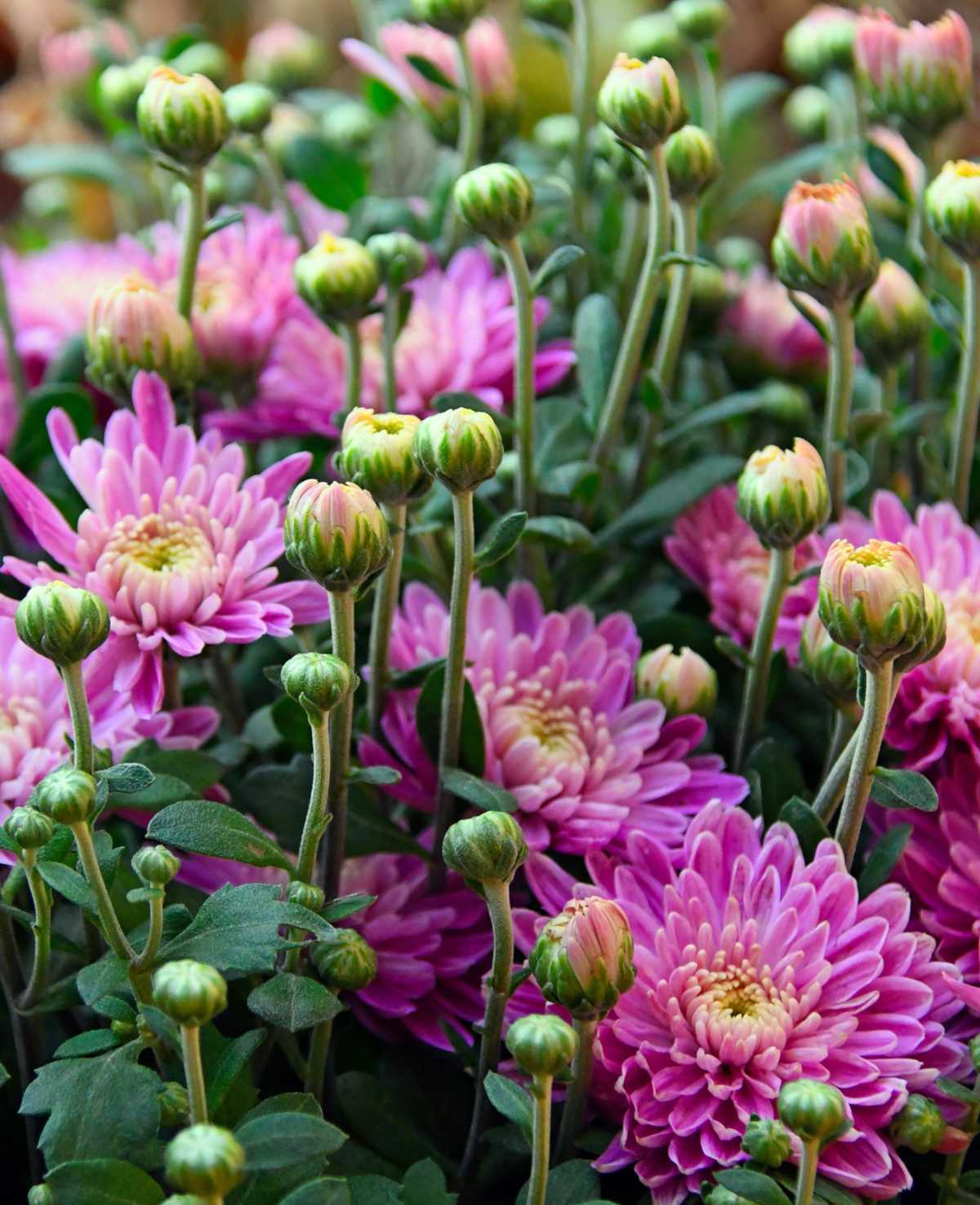
Pruning involves cutting back the chrysanthemum plant to remove dead or diseased foliage, as well as to shape the plant and encourage branching. It is best to prune the plant after it has finished flowering or in early spring before new growth begins.
To prune the chrysanthemum, use clean and sharp pruning shears. Start by cutting off any dead or yellowing leaves near the base of the plant. Then, trim back the main stems to about half their length, cutting just above a set of leaves or buds. This will encourage the plant to produce new side shoots and create a more compact and bushy shape.
Pinching
Pinching is a technique that involves removing the top growth of the chrysanthemum plant to encourage branching and more compact growth. It is typically done when the plant is young and actively growing.
To pinch a chrysanthemum, simply use your thumb and forefinger to pinch off the tip of each stem, just above a set of leaves or buds. This will encourage the plant to produce new side shoots and result in a more bushy and full appearance. Pinching can be done several times throughout the growing season, especially if the plant starts to become tall and leggy.
Both pruning and pinching should be done with care to avoid damaging the plant. It is important to use clean and sharp tools, as well as to make clean cuts to reduce the risk of disease or infection. By regularly pruning and pinching your chrysanthemum in a pot, you can ensure a healthier and more attractive plant.
Dealing with pests and diseases
The chrysanthemum plant is susceptible to various pests and diseases that can affect its health and growth. It is important to monitor your plant regularly and take necessary actions to prevent and control these issues.
Pests
- Aphids: These small insects feed on the sap of the chrysanthemum plant, causing yellowing leaves and stunted growth. Spray the affected plant with insecticidal soap or use a strong stream of water to remove them.
- Mites: Spider mites are tiny pests that suck the sap from the underside of leaves, causing yellow spots and webbing. Regularly misting the plant and keeping the humidity high can help prevent infestations. If mites are present, use an insecticidal soap or neem oil to control them.
- Whiteflies: These small, winged insects feed on the plant’s sap, causing yellowing leaves and a sticky residue. Use yellow sticky traps or apply an insecticidal soap to control the population.
Diseases
- Powdery mildew: This fungal disease appears as a white, powdery coating on the leaves and stems. Remove affected parts and apply a fungicide recommended for powdery mildew.
- Botrytis blight: Also known as gray mold, this disease can cause wilting, rotting, and brown spots on the chrysanthemum plant. Remove affected parts and ensure good air circulation around the plant to prevent the spread of spores.
- Root rot: Overwatering can lead to root rot, which causes the roots to become brown, slimy, and mushy. Ensure proper drainage and reduce watering frequency to prevent this disease.
It is important to regularly inspect your chrysanthemum plant for signs of pests or diseases and take prompt action to prevent their spread. By providing proper care and maintaining a healthy growing environment, you can minimize the risk of these issues and enjoy beautiful, vibrant chrysanthemum blooms.
Propagation methods
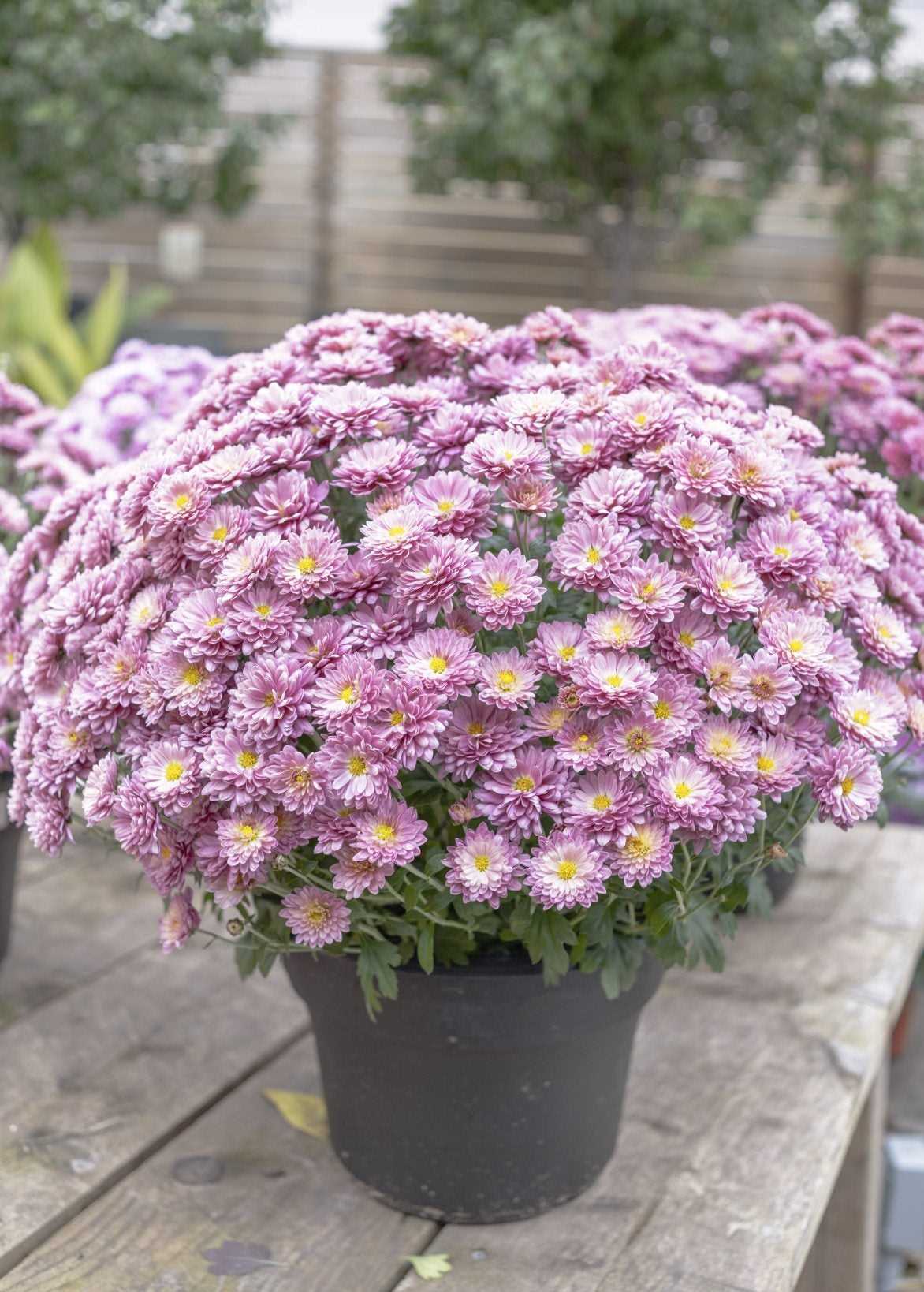
There are several methods for propagating chrysanthemums in a pot:
1. Division
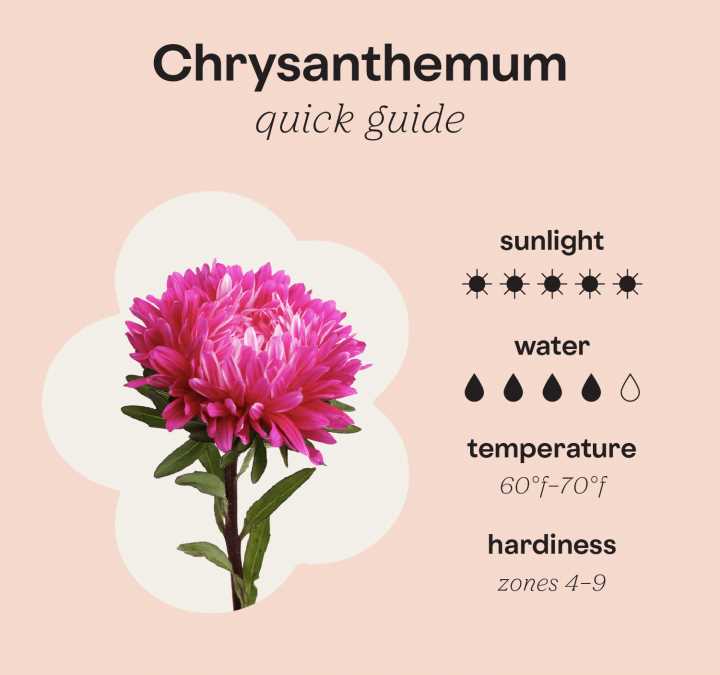
The easiest and most common method of propagation is division. This involves dividing an established chrysanthemum plant into smaller sections, each with its own roots and shoots. To do this, carefully dig up the plant and gently separate the clumps into smaller sections using a sharp knife or garden fork. Make sure each section has a good amount of roots and healthy stems. Replant the divided sections in well-draining soil and water them thoroughly.
2. Stem cuttings
Another popular method is propagation by stem cuttings. This involves taking a cutting from an existing chrysanthemum plant and encouraging it to grow new roots. To do this, select a healthy stem that is about 4-6 inches long and remove any flowers or buds. Dip the end of the stem in rooting hormone to promote root growth, then plant it in a pot filled with well-draining soil. Keep the soil moist and provide indirect sunlight. The cutting should develop roots within a few weeks, at which point it can be transplanted into a larger pot or garden bed.
3. Layering
Layering is a method of propagation that involves encouraging a stem to grow roots while it is still attached to the parent plant. To do this, select a low-growing stem and gently bend it to the ground. Make a small incision in the stem where it touches the ground and secure it in place with a U-shaped wire or a small stone. Cover the incision with soil and keep it moist. Over time, roots will grow from the incision, and once they are well-established, the stem can be severed from the parent plant and transplanted into its own pot.
These are the three main methods of propagating chrysanthemums in a pot. Choose the method that works best for you and enjoy growing your own beautiful and vibrant chrysanthemum plants.
Q&A:
What is the best time to plant chrysanthemums in a pot?
The best time to plant chrysanthemums in a pot is in the spring, after the danger of frost has passed.
How often should I water my potted chrysanthemum plant?
Potted chrysanthemum plants should be watered regularly, keeping the soil moist but not saturated. Water them once or twice a week, depending on the temperature and humidity levels.
Can I keep my potted chrysanthemum indoors?
Yes, you can keep your potted chrysanthemum indoors, but it should be placed in a location where it receives at least 6-8 hours of sunlight per day. It is also important to ensure proper air circulation around the plant.
Do potted chrysanthemums require any fertilization?
Yes, potted chrysanthemums benefit from regular fertilization. Use a balanced fertilizer once a month during the growing season to promote healthy growth and abundant blooms.
How do I prune my potted chrysanthemum plant?
To prune a potted chrysanthemum plant, pinch off any spent blooms and cut back any leggy or overgrown stems. This will help maintain a compact and bushy plant. Pruning should be done in the spring and early summer.
Video:
Best Flowering Plants for Indoors and Outdoors & their complete care







